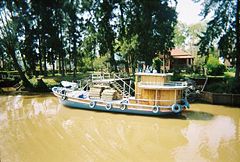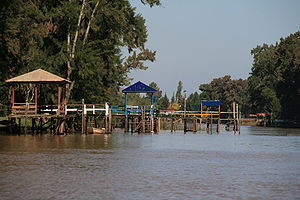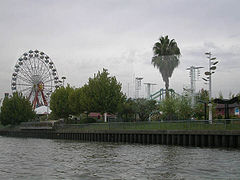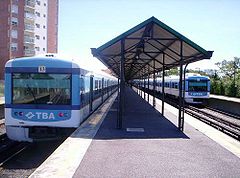
Tigre Partido
Encyclopedia
Tigre Partido is a partido
or municipality of Buenos Aires Province
, Argentina
, situated in the north of Greater Buenos Aires
. The department covers a large section of the Paraná Delta
and its low-lying islands. The main town of the division is Tigre
; other towns include Don Torcuato, El Talar, General Pacheco
, Benavídez.
The partido is bound to the north by the Paraná de las Palmas River
, to the northeast by the Río de la Plata
, to the southeast by San Fernando Partido
, to the south by San Martín Partido
, to the southwest by Malvinas Argentinas Partido
and to the west by Escobar Partido
.
Its total area including the islands is 368 km² and its population was 380,709 as of 2010.
The current mayor is Sergio Massa
, from the Front for Victory
party.
The partido was originally named 'Las Conchas' after a local river (now known as the Reconquista River), but became popularly known as 'Tigre' in the 19th century. Tigre was also the name of a stream and is thought to derive from the tigres or jaguar
s seen in the area when first settled. The municipality officially changed its name to Tigre in 1952.
A port was first built at the mouth of the Las Conchas river, which itself became known as Las Conchas. It served the islands and became an important strategic and smuggling point, targeted by Portuguese, English and Spanish invaders. The partido was officially founded in 1790, but the settlements were hit by floods and the town was moved to the present site of Tigre, at the mouth of the Luján River
by 1820.
Argentine author Jorge Luis Borges
said about Tigre: "no other city do I know that adjoins a secret group of green islands, which get lost at unknown waters of such a slow river that literature called it frozen..."
The hamlet surrounding the port grew as its strategic importance increased, mostly since the 18th century. By 1780 a church had already been built and the parish was established at that time.
Many river rises, floods and heavy rainstorms hit the area. One of the first historically registered catastrophes occurred in early June 1805, when Las Conchas village was almost devastated by a heavy rainstorm that made the river overflow its banks. Most of the people moved to higher nearby lands where San Fernando village was founded, and a channel was built to be used as a new port.
The village was deserted and almost completely abandoned. In August 1820 it was destroyed by a tornado once again. The rising floodwaters trapped the port entrance. At the same time the outflow of water came out through a small stream called Tigre, causing the widening of its bed
and turning it into a river. The port was then moved to its present location by the Tigre River and in time the village was named Tigre.
 During the second half of the 19th century the area became economically and socially more important, mainly due to Domingo F. Sarmiento, president of Argentina from 1868 to 1872. Sarmiento insisted on the favourable development possibilities of the islands and fought for the rights of settlers to own the land they were working on. His house on the island has been turned into a museum that lies on the bank of the river that bears his name.
During the second half of the 19th century the area became economically and socially more important, mainly due to Domingo F. Sarmiento, president of Argentina from 1868 to 1872. Sarmiento insisted on the favourable development possibilities of the islands and fought for the rights of settlers to own the land they were working on. His house on the island has been turned into a museum that lies on the bank of the river that bears his name.
In those decades the country underwent a significant immigration process and many of those immigrants settled on the islands. The railway line to San Fernando, which arrived in 1863 and reached Tigre in 1865, improved communications with Buenos Aires and eased trade of Delta products, basically fresh fruit and its by-products such as fruit juice, jams and cider.
Likewise, the train allowed one-day visits by city dwellers. This favoured the setting up of places to spend the day on the islands, called recreos, and aroused interest in rowing along the quiet waters.
Construction materials from the islands included sun-dried bricks, rush, straw and wood. The simple huts made from these materials were followed by houses made entirely of wood.
In colonial times the area supplied Buenos Aires with firewood and coal. Later on, fruit growing prevailed up to 1940.That year a river rise spoiled most plants and the crisis provoked a mass departure of a large part of the population. The emergence of new fruit markets in other regions of the country hindered the recovery of this traditional economy resource.
Other regional products are wicker baskets and pieces of furniture. The cultivation of osier (salix sp), which is native to European and Asiancold and temperate regions, was proposed by Sarmiento because it can resist floods. Another plant that adapts to floodable lands is New Zealand flax
(phormium tenax
), which was industrialised as from 1925 and is used in containers, burlap, cords, threads, runners and mats. By the end of the 20th century, the competence with synthetic fibres made New Zealand flax plantations anti-economic. Fishing and coypu breeding are other economic activities that are no longer attractive.
Developments in the area include apiculture, camellia and azalea nurseries, handicrafts and timber. At the Delta Products Market of Tigre, various Delta products are sold.


 Towards the end of the 19th century islanders became aware of their identity. They shared their common interest and troubles in the Delta journal, founded in 1933 by a Hungarian immigrant called Sandor Mikler. At that time 20.000 people lived on the islands and the population peaked at 40.000 in the following years.
Towards the end of the 19th century islanders became aware of their identity. They shared their common interest and troubles in the Delta journal, founded in 1933 by a Hungarian immigrant called Sandor Mikler. At that time 20.000 people lived on the islands and the population peaked at 40.000 in the following years.
In 1936 local producers and entrepreneurs founded an association called "Consejo de Productores Isleños" (island producers board) and the following year they declared 31 October to be "islanders day". The celebration takes place every year with the attendance of local authorities and neighbours.
There was an intense social activities on the islands with weekly meetings at the numerous clubs in the area. Weddings were celebrated either in the coastal villages, such as Campana or San Fernando, or in the island chapels. To facilitate religious service on the islands, a floating church to sail along the rivers was set up. As the service was rather expensive it was discontinued towards 1952. The bell tower is now exhibited at the Police Station in Paraná de las Palmas and Carapachay, as a remembrance of those days.
A procession by boat was made by the first time in 1923. Even today, this feast is celebrated on 8 December, the Immaculate Conception day. The procession is headed by the image of Virgin Mary on board of a boat of the "Prefectura Naval Argentina" (national coast guard) and is followed by all types of boats, big and small, commercial and private, all of them decked out for the event. A lot of spectators applaud the march from the banks of the Lujan River.
President Sarmiento was present at the first regatta organised on 8 December 1873. The event was so successful that the existing rowing clubs moved to Tigre, and new ones were founded by members of the various foreign communities residing in Buenos Aires.
Yachting started to be practised in 1883, when the "Yacht Club Argentino", whose headquarters were later moved to San Fernando, was founded, and then at the "Tigre Sailing Club". The Tigre Hotel
, was opened in 1890 on the bank of the Lujan River, and next to it the Tigre Club
was opened in 1912. These elegant buildings became meeting places for the social elite of the "Belle Époque
". The Hotel was demolished in 1940 but the Club is still there today and has been declared a National Historic Monument.
News WebPage: InfoBAN Tigre
Partido
A partido is an administrative subdivision of the . They are formally considered to be a single municipality, and usually contain one or more population centers...
or municipality of Buenos Aires Province
Buenos Aires Province
The Province of Buenos Aires is the largest and most populous province of Argentina. It takes the name from the city of Buenos Aires, which used to be the provincial capital until it was federalized in 1880...
, Argentina
Argentina
Argentina , officially the Argentine Republic , is the second largest country in South America by land area, after Brazil. It is constituted as a federation of 23 provinces and an autonomous city, Buenos Aires...
, situated in the north of Greater Buenos Aires
Greater Buenos Aires
Greater Buenos Aires is the generic denomination to refer to the megalopolis comprising the autonomous city of Buenos Aires and the conurbation around it, over the province of Buenos Aires—namely the adjacent 24 partidos or municipalities—which nonetheless do not constitute a single administrative...
. The department covers a large section of the Paraná Delta
Paraná Delta
The Paraná Delta is the delta of the Paraná River in Argentina. The Paraná flows north–south and becomes an alluvial basin between the Argentine provinces of Entre Ríos and Santa Fe, then emptying into the Río de la Plata....
and its low-lying islands. The main town of the division is Tigre
Tigre, Buenos Aires
Tigre is a town in the Buenos Aires Province, Argentina, situated in the north of Greater Buenos Aires, north of Buenos Aires city. Tigre lies on the Paraná Delta and is an important tourist and weekend attraction, easily reached by bus and train services, including the scenic Tren de la Costa...
; other towns include Don Torcuato, El Talar, General Pacheco
General Pacheco
General Pacheco is a city in Tigre Partido, Buenos Aires Province, Argentina. The city's position inside Tigre significantly sums up to its importance inside the partido...
, Benavídez.
The partido is bound to the north by the Paraná de las Palmas River
Paraná River
The Paraná River is a river in south Central South America, running through Brazil, Paraguay and Argentina for some . It is second in length only to the Amazon River among South American rivers. The name Paraná is an abbreviation of the phrase "para rehe onáva", which comes from the Tupi language...
, to the northeast by the Río de la Plata
Río de la Plata
The Río de la Plata —sometimes rendered River Plate in British English and the Commonwealth, and occasionally rendered [La] Plata River in other English-speaking countries—is the river and estuary formed by the confluence of the Uruguay River and the Paraná River on the border between Argentina and...
, to the southeast by San Fernando Partido
San Fernando Partido
San Fernando is a partido of Buenos Aires Province, Argentina, in the north of Greater Buenos Aires. Its capital is San Fernando. It is 28 km. from the city of Buenos Aires.-Population distribution :...
, to the south by San Martín Partido
General San Martín Partido
General San Martín Partido is a partido in the Gran Buenos Aires urban area, immediately to the north-west of Capital Federal in Buenos Aires Province, Argentina....
, to the southwest by Malvinas Argentinas Partido
Malvinas Argentinas Partido
Malvinas Argentinas Partido is a partido in Buenos Aires Province, Argentina, in the Gran Buenos Aires urban area. It has an area of and a population of 321,833 ....
and to the west by Escobar Partido
Escobar Partido
Escobar Partido is a partido situated in the northern part of the Gran Buenos Aires urban area, in Buenos Aires Province, Argentina.The provincial subdivision has a population of about 178,000 inhabitants in an area of , and its capital city is Belén de Escobar, which is located from Buenos...
.
Its total area including the islands is 368 km² and its population was 380,709 as of 2010.
The current mayor is Sergio Massa
Sergio Massa
Sergio Tomás Massa is an Argentine Justicialist Party politician and was the President's Cabinet Chief from July 2008 to July 2009....
, from the Front for Victory
Front for Victory
The Front for Victory is a Peronist political party and electoral alliance in Argentina, although it is formally a faction of the Justicialist Party. Both the former President Néstor Kirchner and the current President Cristina Fernández de Kirchner belong to this party, located on the left-wing...
party.
The partido was originally named 'Las Conchas' after a local river (now known as the Reconquista River), but became popularly known as 'Tigre' in the 19th century. Tigre was also the name of a stream and is thought to derive from the tigres or jaguar
Jaguar
The jaguar is a big cat, a feline in the Panthera genus, and is the only Panthera species found in the Americas. The jaguar is the third-largest feline after the tiger and the lion, and the largest in the Western Hemisphere. The jaguar's present range extends from Southern United States and Mexico...
s seen in the area when first settled. The municipality officially changed its name to Tigre in 1952.
A port was first built at the mouth of the Las Conchas river, which itself became known as Las Conchas. It served the islands and became an important strategic and smuggling point, targeted by Portuguese, English and Spanish invaders. The partido was officially founded in 1790, but the settlements were hit by floods and the town was moved to the present site of Tigre, at the mouth of the Luján River
Luján River
The Luján River runs from its source near Espora about east of Buenos Aires, Argentina to its outflow into the Río de la Plata north of the city.-See also:* List of rivers of Argentina-External links:*...
by 1820.
Argentine author Jorge Luis Borges
Jorge Luis Borges
Jorge Francisco Isidoro Luis Borges Acevedo , known as Jorge Luis Borges , was an Argentine writer, essayist, poet and translator born in Buenos Aires. In 1914 his family moved to Switzerland where he attended school, receiving his baccalauréat from the Collège de Genève in 1918. The family...
said about Tigre: "no other city do I know that adjoins a secret group of green islands, which get lost at unknown waters of such a slow river that literature called it frozen..."
Colonial Times
The history of Tigre dates back to a port on the banks of Las Conchas River, which gave origin to Las Conchas Village. The port was used by the ships sailing the Paraná River to or from Paraguay and also by those who carried wood, coal and firewood from the Delta to Buenos Aires. Las Conchas River (named after the sea shell debris that was abundant in the riverbed) is now called Reconquista and runs along Liniers street.The hamlet surrounding the port grew as its strategic importance increased, mostly since the 18th century. By 1780 a church had already been built and the parish was established at that time.
Many river rises, floods and heavy rainstorms hit the area. One of the first historically registered catastrophes occurred in early June 1805, when Las Conchas village was almost devastated by a heavy rainstorm that made the river overflow its banks. Most of the people moved to higher nearby lands where San Fernando village was founded, and a channel was built to be used as a new port.
The village was deserted and almost completely abandoned. In August 1820 it was destroyed by a tornado once again. The rising floodwaters trapped the port entrance. At the same time the outflow of water came out through a small stream called Tigre, causing the widening of its bed
and turning it into a river. The port was then moved to its present location by the Tigre River and in time the village was named Tigre.
Promotion of the Paraná River Delta in the XIX century

In those decades the country underwent a significant immigration process and many of those immigrants settled on the islands. The railway line to San Fernando, which arrived in 1863 and reached Tigre in 1865, improved communications with Buenos Aires and eased trade of Delta products, basically fresh fruit and its by-products such as fruit juice, jams and cider.
Likewise, the train allowed one-day visits by city dwellers. This favoured the setting up of places to spend the day on the islands, called recreos, and aroused interest in rowing along the quiet waters.
Island dwellers
The earliest inhabitants of the islands were indigenous groups called guaraníes. In colonial times there was no stable population but nomadic hunters or firewood and coal seekers. Occasionally, it was also a smuggler's hiding place. From the moment Sarmiento encouraged development, new settlers came to the islands to live of the commercial exploitation of their products.Construction materials from the islands included sun-dried bricks, rush, straw and wood. The simple huts made from these materials were followed by houses made entirely of wood.
Delta economy
The early inhabitants lived mostly by hunting and fishing and on small palm coconuts (cocos australis). A few tribes sowed corn and peanuts, and grew fruit trees.In colonial times the area supplied Buenos Aires with firewood and coal. Later on, fruit growing prevailed up to 1940.That year a river rise spoiled most plants and the crisis provoked a mass departure of a large part of the population. The emergence of new fruit markets in other regions of the country hindered the recovery of this traditional economy resource.
Other regional products are wicker baskets and pieces of furniture. The cultivation of osier (salix sp), which is native to European and Asiancold and temperate regions, was proposed by Sarmiento because it can resist floods. Another plant that adapts to floodable lands is New Zealand flax
New Zealand flax
New Zealand flax describes common New Zealand perennial plants Phormium tenax and Phormium cookianum, known by the Māori names harakeke and wharariki respectively...
(phormium tenax
Phormium tenax
Phormium tenax is an evergreen perennial plant native to New Zealand and Norfolk Island that is an important fibre plant and a popular ornamental plant...
), which was industrialised as from 1925 and is used in containers, burlap, cords, threads, runners and mats. By the end of the 20th century, the competence with synthetic fibres made New Zealand flax plantations anti-economic. Fishing and coypu breeding are other economic activities that are no longer attractive.
Developments in the area include apiculture, camellia and azalea nurseries, handicrafts and timber. At the Delta Products Market of Tigre, various Delta products are sold.
Islanders' social life, tourism: The "Recreos"



In 1936 local producers and entrepreneurs founded an association called "Consejo de Productores Isleños" (island producers board) and the following year they declared 31 October to be "islanders day". The celebration takes place every year with the attendance of local authorities and neighbours.
There was an intense social activities on the islands with weekly meetings at the numerous clubs in the area. Weddings were celebrated either in the coastal villages, such as Campana or San Fernando, or in the island chapels. To facilitate religious service on the islands, a floating church to sail along the rivers was set up. As the service was rather expensive it was discontinued towards 1952. The bell tower is now exhibited at the Police Station in Paraná de las Palmas and Carapachay, as a remembrance of those days.
A procession by boat was made by the first time in 1923. Even today, this feast is celebrated on 8 December, the Immaculate Conception day. The procession is headed by the image of Virgin Mary on board of a boat of the "Prefectura Naval Argentina" (national coast guard) and is followed by all types of boats, big and small, commercial and private, all of them decked out for the event. A lot of spectators applaud the march from the banks of the Lujan River.
The golden years of Tigre
Rowing was one of the main attractions that fuelled the boom of the area. Rowing practice had started in the south of Buenos Aires and little by little was moved to the Luján river due to the tranquility and beauty of the place.President Sarmiento was present at the first regatta organised on 8 December 1873. The event was so successful that the existing rowing clubs moved to Tigre, and new ones were founded by members of the various foreign communities residing in Buenos Aires.
Yachting started to be practised in 1883, when the "Yacht Club Argentino", whose headquarters were later moved to San Fernando, was founded, and then at the "Tigre Sailing Club". The Tigre Hotel
Tigre Hotel
The Tigre Hotel stood on the banks of the Luján River, in Paseo Victorica, Tigre, near Buenos Aires, Argentina. Inaugurated on 12 January 1890, it soon became an important social, tourist and sporting centre, not only for the people of Tigre, but also for porteños...
, was opened in 1890 on the bank of the Lujan River, and next to it the Tigre Club
Tigre Club
The Tigre Club stands on the banks of the Luján River, in Paseo Victorica, Tigre, near Buenos Aires, Argentina. The Club, built next to the Tigre Hotel , was financed by Ernesto Tornquist, and was designed by the architects Pablo Pater, Luis Dubois and the engineer Emilio Mitre , and was opened on...
was opened in 1912. These elegant buildings became meeting places for the social elite of the "Belle Époque
Belle Époque
The Belle Époque or La Belle Époque was a period in European social history that began during the late 19th century and lasted until World War I. Occurring during the era of the French Third Republic and the German Empire, it was a period characterised by optimism and new technological and medical...
". The Hotel was demolished in 1940 but the Club is still there today and has been declared a National Historic Monument.
External links
Municipalidad de Tigre Fotos de Tigre Casino de Tigre Parque de la Costa Club de Regatas La Marina (Rowing)News WebPage: InfoBAN Tigre

